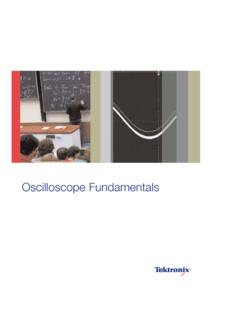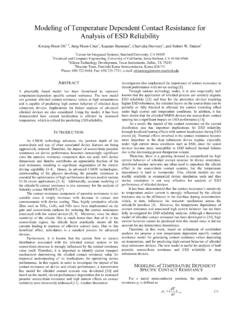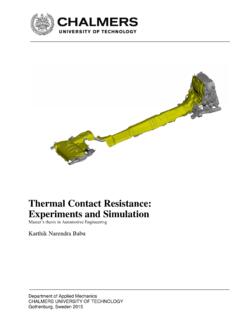Transcription of Effects of heat treatment and contact resistance on the ...
1 Effects of heat treatment and contact resistance on the thermal conductivityof individual multiwalled carbon nanotubes using a Wollaston wire thermalprobeMichael F. P. Bifano, Jungkyu Park, Pankaj B. Kaul, Ajit K. Roy, and Vikas Prakash Citation: J. Appl. Phys. 111, 054321 (2012); doi: View online: View Table of Contents: Published by the American Institute of Physics. Related ArticlesPressure dependency of thermal boundary conductance of carbon nanotube/silicon interface: A moleculardynamics study J. Appl. Phys. 112, 053501 (2012) Investigation of thermal properties of mid-infrared AlGaAs/GaAs quantum cascade lasers J. Appl. Phys. 112, 043112 (2012) Opposite ReD-dependencies of nanofluid (Al2O3) thermal conductivities between heating and cooling modes Appl. Phys. Lett. 101, 083111 (2012) thermal transport in graphene supported on copper J.
2 Appl. Phys. 112, 043502 (2012) thermal conductivity of self-assembled nano-structured ZnO bulk ceramics J. Appl. Phys. 112, 034313 (2012) Additional information on J. Appl. Homepage: Journal Information: Top downloads: Information for Authors: Downloaded 10 Sep 2012 to Redistribution subject to AIP license or copyright; see of heat treatment and contact resistance on the thermalconductivity of individual multiwalled carbon nanotubes using a Wollastonwire thermal probeMichael F. P. Bifano,1 Jungkyu Park,1 Pankaj B. Kaul,1 Ajit K. Roy,2and Vikas Prakash1,a)1 Department of Mechanical and Aerospace Engineering, Case Western Reserve University, Cleveland,Ohio, 44106, USA2 Air Force Research Laboratory, Materials and Manufacturing Directorate, Wright Patterson Air Force Base,Dayton, Ohio, 45433, USA(Received 15 August 2011; accepted 4 February 2012; published online 15 March 2012) thermal conductivity measurements in commercially available, chemical vapor deposition grown,heat-treated and non-heat-treated multiwalled carbon nanotubes (MWCNTs) are reported.
3 Thethermal conductivity of individual samples is measured using a suspended platinum wire as athermal resistance probe in a T-type configuration. Changes in third harmonic voltage aremeasured across the heated suspended platinum wire as a specimen is attached to the platinumwire s midpoint. An analytic model is used to correlate the reduction in the average temperature ofthe probe wire to the thermal resistance (and thermal conductivity) of the attached are implemented inside a scanning electron microscope equipped withnanomanipulators for sample selection, and a gas injection system for platinum based electronbeam-induced deposition to improve thermal contact resistances. The results indicate a nearly 5-foldincreaseintheaveragethermalconduct ivityofMWCNT samplesannealedwith a 20-h 3000 C annealing heat treatment compared to the as-grown samples.
4 However,specimen-specific morphological defects, such as kinking, Y-branches, etc., are found to negate, to alarge degree, the advantage of the heat treatment process. The thermal contact resistance betweenthe MWCNT and the electron beam induced deposition contacts is estimated using an anisotropicdiffusive mismatch model that includes the effect of fin resistance . Adjusting the thermalconductivity to include the effect of thermal contact resistance is found to increase the thermalconductivity by approximately 5%. Once adjusted for thermal contact resistance , the averagethermal conductivity of the heat-treated MWCNT specimens is 228 W/m-K, with the highestmeasured thermal conductivity being 7656150 W/m-K. The results highlight the importance ofMWCNT quality in thermal management American Institute of Physics.
5 [ ]I. INTRODUCTIONT here is little agreement among the few reported ther-mal conductivity measurements1 5in MWCNTs. This islikely due to the vast structural and chemical variations insamples. Room temperature thermal conductivity measure-ments in MWCNTs have been reported to be as high as 3000W/m-K,1and as low as 17 chemical vapordeposition (CVD) process commonly used in the synthesisof MWCNTs is known to produce a variety of carbon nano-tube qualities depending on growth temperature, catalyst,and carbon source gases 2001 study7showed many structural and chemicalimprovements in CVD-grown MWCNTs with high tempera-ture annealing. Annealing temperatures that exceeded2250 C were found to produce X-ray diffraction patternssimilar to those of highly graphitic MWCNTs grown byarc-discharge methods.
6 Smaller interlayer wall spacing,indicative of highly graphitic structures, were also possiblewith higher annealing temperatures up to 3000 C. ResidualFe, the primary chemical vapor deposition growth catalyst forMWCNTs, was also found to reduce from by wt. afterCVD growth to less than Major Fe reduction occurredboth at the ends and in the core of the MWCNTs once theannealing temperature surpassed the vaporization temperatureof Fe (>1800 C). While heat treatment improved themicrostructural quality of the samples, larger defects that cre-ated kinks and branching in the tubes were not removed inthe heat- treatment process. More continuous crystallineplanes and a reduction in residual catalyst particles areexpected to increase phonon mean free path (MFP) and thusincrease the lattice (phonon) thermal conductivity recently, Jinet that annealing ofmacroscopic MWCNT bundles at 2800 Cfor4hresultedina 9-fold increase in thermal conductivity at 300 K ( to 23W/m-K).
7 However, from these measurements, an improve-ment in intrinsic thermal conductivity of an individualMWCNT could not be ascertained. To the authors knowl-edge, heat- treatment Effects on the thermal conductivity ofindividual MWCNTs have not been )Author to whom correspondence should be addressed. Electronic American Institute of Physics111, 054321-1 JOURNAL OF APPLIED PHYSICS111, 054321 (2012)Downloaded 10 Sep 2012 to Redistribution subject to AIP license or copyright; see the past 50 years, thermal properties of electricallyconductive samples and/or their surrounding media havebeen investigated by measuring the 3rd harmonic voltagesignal produced when a sample is Joule heated via an electricalternating 11 Comparing the measured 3rd har-monic voltage across the sample with an analytic model per-mits the thermal properties of the sample to be most simplistic steady-state thermal conductivity mea-surement method is the self-heating gen-eral, the self-heating method requires samples to beelectrically conductive, transport heat diffusively, and thetemperature coefficient of resistance of the sample to beknown.
8 The self-heating method was first applied to a bundleof CNTs12and subsequently to individual extension of the self-heating technique is the T-type probe method, which replaces the sample with apre-calibrated suspended wire of known electrical resistivityand temperature coefficient of resistance ( ). In thisway, by attaching a free standing specimen to the probe wireand measuring the reduction in average temperature (inferredfrom the change in voltage) of the probe wire, the thermal re-sistance and, thus, thermal conductivity of the specimen isdetermined. To date, the T-type method has been used tomeasure a variety of microscale ,14In 2005, Fujiiet the method to a micro-fabricated platinum(Pt) probe that used3xvoltage detection to measure thethermal conductivity of individual this study, a T-type probe composed of Wollastonwire is implemented.
9 The use of commercially availableWollaston wire was first introduced in 2007 in both1xand3xconfigurations for thermal conductivity measure-ments in individual MWCNTs at room , only one measurement of 17 W/m-K was to prior literature values, the low value of thethermal conductivity was attributed either to high thermalcontact resistance at the probe-sample interface and/or thepossibility of ballistic transport in the short length of sam-ple (380 nm) experimental techniques to measure thermal con-ductivity in individual nanoscale samples currently employ amicro-fabricated sensing ,2,15,16 Use of commerciallyavailable Wollaston wire has the advantage of beingextremely cost effective when compared to conventionalmicrofabrication methods and allows for a large volume ofsamples to be characterized in a short span of time.
10 In thepresent investigation, all thermal property characterizationstudies are conducted inside a high-resolution scanningelectron microscope equipped with nanomanipulators and agas injection system. Moreover, the choice of materials andpackage design allows for multiple Wollaston T-type probesto be prepared with varying thermal resistances and, thus,measurement METHODSA. Low frequency three omega analysisIn order to conduct the three omega measurements, theprobe wire is heated by a low frequency alternating currentI(t) I1xsin(xt), whereI1xis the current amplitude. Theelectrical resistance of the probe wire at zero current sufficiently low heating currentsI(t), Joule heating isassumed to have the formQ t I2 t Reo 12I21xReo 1 cos 2xt :(1)While conducting the experiments, attention must be paid tomaintain the validity of Eq.










